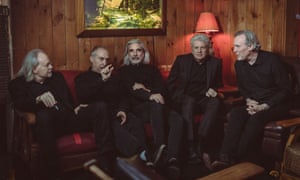Underground scenes like noise and vaporwave are reaching for their ten-gallon hats, musically speaking – and soothing their pets in the process
April Clare Welsh
Tue 9 Jun 2020 11.13 BSTLast modified on Thu 11 Jun 2020 14.12 BST
For a few hours one Tuesday last May, Brooklyn felt like a lonesome prairie. Oakland-based composer and guitarist Chuck Johnson had taken the opening slot at Union Pool, performing a set of solo instrumentals on pedal steel guitar, the sustain-rich country music instrument that can hauntingly convey human weeping. The headline act, NYC quintet Suss, played a medley of the self-described “ambient country” soundscapes that they had been making since casually forming at a party some years before.
“We might capture this big sky Montana feel, but we’re urban musicians,” Suss co-founder Bob Holmes says over the phone from his Manhattan apartment. Back in the 80s, he was a member of US cowpunk trailblazers Rubber Rodeo – now, he’s pushing a placid alternative vision for country. “It’s about two words: high and lonesome. You get the feeling of expansiveness, of tugging at the heartstrings. It’s warm and inviting music that creates spaces you just fall into and fall in love with.”
Country songs traditionally tell stories, but Suss and Chuck Johnson are part of a new crop of artists who emphasise abstract expression over linear narrative and conventional structures. These musicians continue a legacy that joins the dots between country and post-rock, experimental music and world-class pedal steel pioneers such as Susan Alcorn, Robert Randolph and Sarah Jory. Brian Eno’s 1983 LP Apollo: Atmospheres and Soundtracks, which features Daniel Lanois on pedal steel guitar, and Bruce Kaphan’s 2005 album Sliderare some of the hybrid genre’s touchstones.

With its various knee levers and strings, the pedal steel guitar – which originated, pre-pedals, in Hawaii – is difficult to learn and conventionally used as part of a band. “It’s basically a machine rather than an instrument, a product of the 20th-century industrial age,” Johnson says. “You might as well be operating a forklift and be trying to make it sound pretty.” Johnson remembers his first encounter with the pedal steel guitar, back in his home town of Durham, North Carolina. “It was a total disaster. I couldn’t make anything happen with it, which was humbling, to the point that I didn’t pursue it again for many years.”
Johnson did go on to master the instrument and has crafted evocative soundtracks for film, including HBO documentary Private Violence and Emmy award-winning TV show A Chef’s Life. Then, in 2017, he answered a challenge from his label to create a solo album of pedal steel guitar music. Balsamsultimately doubled up as a balm for his injured dog Bubbles, who was recovering from a spinal injury. “I needed to make music that would keep her relaxed as she was nearby while I was working, and she’s very sensitive to music,” Johnson says, as she barks away in the background. “She tends to prefer drony minimalist music and listens to ambient all the time.” The result is a silvery, soothing guitar record with subtle electronic flourishes.
Elsewhere, Kobe City’s Ztom Motoyama, New York’s Eerie Gaits, and sprawling Austin band Balmorhea mine similarly serenely mellowed-out soundscapes that create a sense of place, often evoking sundown vistas and wide-open expanses. But there are also a number of avant-garde artists recontextualising country and western-inspired sounds and ideas. Across Buck Young’s two albums of country folk-tinged and Americana noise cut-ups – 2018’s Proud Trash Sound and Buck II: Where Do You Want It? – you will hear a myriad samples and field recordings, from a howling freight train rolling across the US to a galloping, saloon-style piano loop soundtracking a vintage western gunfight.
Buck Young’s Zoe Burke refers to the group’s collage-like approach as “extreme sound mulching”, explaining that the audio was taken apart and put back together several times. “This is a country record made by noise musicians,” she says, referencing the pan-US collective who try to capture a “nebulous and distant America” with their work. “It turned into a project about being constantly in motion, just as much as a nod to perceived histories of American music.” Pedal steel guitar from maestro Alan Jones, warped and manipulated to queasy effect, lends a traditional yet eerie ambience.
Burke felt drawn to country after feeling displaced when their Baltimore show space was forced to shut down following neglect from the “slumlord” they were renting from. “Using not-so-legal methods of travelling around the country for long stretches of time, beholden to the bizarre nooks and crannies of this country – how can you not make country music after going through something like that?”

Read more
She says Buck Young are attracted to the “uniquely American despondency” of country: “I think that much of the best American experimental music yields the same end result.” And she says discovering artists from “the dark annals of country music” like Ramblin’ Red Bailey, Harry Johnson, Hi-Fi Guys and those featured on the God Less America compilation in 1995 “was like finding a ripped-out chapter in a history book; the Mickey Mouse mask ripped off from a musical tradition that is more twisted than any contemporary music”.
Country music is constantly evolving – as well as mainstream genre splicings by the likes of Avicii and Lil Nas X in recent years, it has found a niche in underground styles ranging from vaporwave and chopped and screwed hip-hop topsytrance. For Burke, the whole genre is experiencing a profound shift. “The reconsideration of the classic white male cowboy archetype is breathing new life into country music and absolutely to American culture as a whole, how we interpret history, and the future,” she says. “We are on the cusp of something wonderful, a genre-bending reinvigorating cataclysm, and I can’t wait to see what the future of country music’s got in store.”